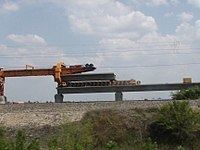Type High-speed rail Stations 23 Rolling stock CRH380BG | Status Operational Opened December 1, 2012 Locale China | |
 | ||
Operator(s) China Railway High-speed Terminis Dalian North Railway Station, Harbin West Railway Station | ||
The Harbin–Dalian High-Speed Railway or Hada Railway (Chinese: 哈大高速铁路; pinyin: Hādà Gāosù Tiělù) is a high-speed rail line connecting Harbin and Dalian, in China. Construction work began on August 23, 2007 and the first commercial services began operating in December 1, 2012, nearly one year behind schedule. The line is the world's first alpine high-speed railway operating at high latitudes and low temperatures in winter. The trains can continue operating even with snow on the line and the tracks are fitted with de-icing technology. The project cost CN¥95 billion, which was 25% more than the original budget.
The railway is the northernmost high-speed line in China. The climate of northeast China poses a challenge to the design; parts of the line had to be rebuilt before the opening due to deformation caused by frost heaving. Eventually, it was decided that the route could be opened for commercial services on December 1, 2012; however, during winters (December through March) it operates a winter timetable, with the maximum running speed of 250 km/h. In summer, the service runs an expanded timetable with services running at a higher speed of up to 350 km/h. However, the line has a design speed of up to 350 km/h. The summer high-speed services also have higher ticket prices than the slower winter service; however, some trains continue to run all year at the 250 km/h speed and lower price, giving travellers a choice of speed versus ticket price.
Under the winter timetable, the 921 km journey from Dalian to Harbin takes five hours eighteen minutes. In summer, the higher speeds reduce the journey time to just three and a half hours.
Test runs along the entire railway started on October 8, 2012. These were restricted to the winter service speed of 250 km/h. The first commercial passenger services started on December 1, 2012 with two trains leaving simultaneously, one from Dalian and the other from the new Harbin West station. During the first 52 days of operation, the line transported 2.856 million passengers. By the end of March, there had been 9.4 million passenger trips on the line, an average of 78,000 per day. During the four weeks of the Chinese spring festival, passengers reached peaks of 164,000 per day.
Testing of services at the increased summer speed of 350 km/h began in April 2013 after a delay of one month. Commercial services on the summer schedule began on the April 21st, 2013. The line operates 67 pairs of CRH380BG type alpine EMU trains. These have been specially modified for the Hada railway which must cope with temperatures as low as -40°C in winter. Extra insulation has been added within the skin of the carriages and even the vacuum toilets have been modified to operate in this extreme cold.
The track has been specially designed to cope with extremes in temperature. In winter, the temperatures on the route can fall below -40°C while in summer they can hit 40°C above. Heavy snowfall in the area is also common during winter. This large change in temperature can cause frost heave. As the water in the ground freezes in winter, it expands. In summer the ice melts and water drains causing shrinkage. This creates distortion on the ground surface that ordinary high speed railway lines could not cope with. To combat frost heave, 70% of the line is constructed above the ground surface on viaducts. During construction, about 20 percent of the track that had been built directly on the ground had to be redesigned and rebuilt due to frost damage. This delayed the opening of the line by about a year.
